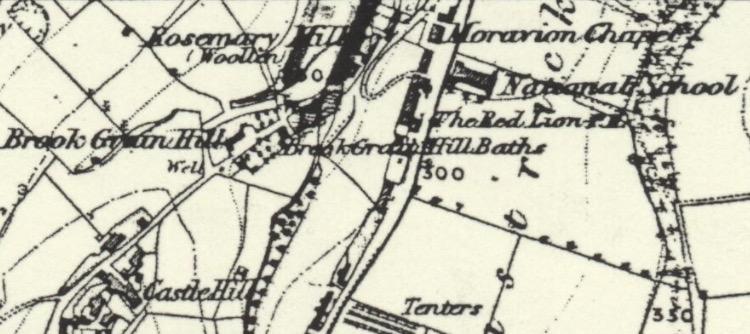This area was known as Rosemary Park and here, we once again encounter the Fryer family as Rastrick land-owners. In 1773, Sir John Lister-Kaye sold the land to Dr. Joseph Fryer. There was a further land sale in 1802 where there is mention of a newly erected water mill, steam engine and dye-house.
In 1829, Dr. Fryer’s two eldest sons, Joseph and William are shown as merchants, bombazine manufacturers and manufacturers of fancy goods in Pigot’s Directory of 1829. Bombazine was a silk and wool fabric which was highly fashionable in ladies clothing whilst the fancy goods refers to flamboyant waistcoats worn by gentlemen of that time. This suggests that Joseph & William Fryer were manufacturing textiles at Rosemary Mill in 1829 and probably several years prior to that date.
Joseph and William Fryer’s partnership was dissolved in 1836 as William spent more time in London and the business was handed to two of Joseph’s sons, Charles and Joseph Jowett Fryer but the latter named son and his father both died in 1846 at which point the family decided to off-load the land and property.
The Leeds Mercury dated 8th May 1847 carried an advert for the sale of the land. The sale was held on the 17th May 1847 at the Thornhill Arms, Rastrick. Amongst the several lots, Lot 11 was described as a substantial stone built three storey mill called Rosemary Mill measuring 60ft x 40ft. It comprised of the ‘mill, engine house, shafting, 12 horse boiler, joiners shop, cottage, outbuildings, stone bridge and approach, dam, weir, goit and a close of land called Rosemary Park in the occupation of J.J. & C Fryer’
Lot 12 was ‘all that garden with the bath, adjoining Lot 11 in the occupation of J.J. & C. Fryer containing 810 superficial square yards, more or less’
The ‘bath’ referred to in the advert was actually the public baths where, in the days when most houses didn’t have a bathroom, workers could go and have a good wash. They consisted of outdoor stone troughs which were purchased through public subscription in 1758. The baths were fed by the stream that we mentioned earlier, which springs at Lower Cote, Fixby and travels down the valley through Carr Green. I would imagine they were very cold in the winter months.
It would appear that the purchaser was Joshua Garside Wilson who we met a short time ago at Ivy House. In 1851 he was living with his sister and her husband, John Craven at Brookrennels, an old name for this area of Rastrick. Both men are shown as woollen fancy manufacturers in the census records and Wilson was running his company, J. Wilson & Co. from Rosemary Mills. The first mention of his ownership is in the 1857 electoral rolls where he is shown as owning not only Rosemary Mill but also the Oddfellows Hall in Brighouse.
In 1829, Dr. Fryer’s two eldest sons, Joseph and William are shown as merchants, bombazine manufacturers and manufacturers of fancy goods in Pigot’s Directory of 1829. Bombazine was a silk and wool fabric which was highly fashionable in ladies clothing whilst the fancy goods refers to flamboyant waistcoats worn by gentlemen of that time. This suggests that Joseph & William Fryer were manufacturing textiles at Rosemary Mill in 1829 and probably several years prior to that date.
Joseph and William Fryer’s partnership was dissolved in 1836 as William spent more time in London and the business was handed to two of Joseph’s sons, Charles and Joseph Jowett Fryer but the latter named son and his father both died in 1846 at which point the family decided to off-load the land and property.
The Leeds Mercury dated 8th May 1847 carried an advert for the sale of the land. The sale was held on the 17th May 1847 at the Thornhill Arms, Rastrick. Amongst the several lots, Lot 11 was described as a substantial stone built three storey mill called Rosemary Mill measuring 60ft x 40ft. It comprised of the ‘mill, engine house, shafting, 12 horse boiler, joiners shop, cottage, outbuildings, stone bridge and approach, dam, weir, goit and a close of land called Rosemary Park in the occupation of J.J. & C Fryer’
Lot 12 was ‘all that garden with the bath, adjoining Lot 11 in the occupation of J.J. & C. Fryer containing 810 superficial square yards, more or less’
The ‘bath’ referred to in the advert was actually the public baths where, in the days when most houses didn’t have a bathroom, workers could go and have a good wash. They consisted of outdoor stone troughs which were purchased through public subscription in 1758. The baths were fed by the stream that we mentioned earlier, which springs at Lower Cote, Fixby and travels down the valley through Carr Green. I would imagine they were very cold in the winter months.
It would appear that the purchaser was Joshua Garside Wilson who we met a short time ago at Ivy House. In 1851 he was living with his sister and her husband, John Craven at Brookrennels, an old name for this area of Rastrick. Both men are shown as woollen fancy manufacturers in the census records and Wilson was running his company, J. Wilson & Co. from Rosemary Mills. The first mention of his ownership is in the 1857 electoral rolls where he is shown as owning not only Rosemary Mill but also the Oddfellows Hall in Brighouse.
This area was known as Rosemary Park and here, we once again encounter the Fryer family as Rastrick land-owners. In 1773, Sir John Lister-Kaye sold the land to Dr. Joseph Fryer. There was a further land sale in 1802 where there is mention of a newly erected water mill, steam engine and dye-house.
In 1829, Dr. Fryer’s two eldest sons, Joseph and William are shown as merchants, bombazine manufacturers and manufacturers of fancy goods in Pigot’s Directory of 1829. Bombazine was a silk and wool fabric which was highly fashionable in ladies clothing whilst the fancy goods refers to flamboyant waistcoats worn by gentlemen of that time. This suggests that Joseph & William Fryer were manufacturing textiles at Rosemary Mill in 1829 and probably several years prior to that date.
Joseph and William Fryer’s partnership was dissolved in 1836 as William spent more time in London and the business was handed to two of Joseph’s sons, Charles and Joseph Jowett Fryer but the latter named son and his father both died in 1846 at which point the family decided to off-load the land and property.
The Leeds Mercury dated 8th May 1847 carried an advert for the sale of the land. The sale was held on the 17th May 1847 at the Thornhill Arms, Rastrick. Amongst the several lots, Lot 11 was described as a substantial stone built three storey mill called Rosemary Mill measuring 60ft x 40ft. It comprised of the ‘mill, engine house, shafting, 12 horse boiler, joiners shop, cottage, outbuildings, stone bridge and approach, dam, weir, goit and a close of land called Rosemary Park in the occupation of J.J. & C Fryer’
Lot 12 was ‘all that garden with the bath, adjoining Lot 11 in the occupation of J.J. & C. Fryer containing 810 superficial square yards, more or less’
The ‘bath’ referred to in the advert was actually the public baths where, in the days when most houses didn’t have a bathroom, workers could go and have a good wash. They consisted of outdoor stone troughs which were purchased through public subscription in 1758. The baths were fed by the stream that we mentioned earlier, which springs at Lower Cote, Fixby and travels down the valley through Carr Green. I would imagine they were very cold in the winter months.
It would appear that the purchaser was Joshua Garside Wilson who we met a short time ago at Ivy House. In 1851 he was living with his sister and her husband, John Craven at Brookrennels, an old name for this area of Rastrick. Both men are shown as woollen fancy manufacturers in the census records and Wilson was running his company, J. Wilson & Co. from Rosemary Mills. The first mention of his ownership is in the 1857 electoral rolls where he is shown as owning not only Rosemary Mill but also the Oddfellows Hall in Brighouse.
0 Commentarii
·0 Distribuiri
·889 Views
·0 previzualizare




